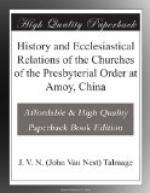Presbytery of Siam—Has 6 ministers; no native pastor; 1 church; 8 communicants. (How many of these are native members not reported.)
Presbytery of West Africa—Has 9 ministers; no native pastor; 6 churches; 191 communicants (probably all natives.)
Are these ecclesiastical bodies respectively Indian, Chinese, and African in their character? or are they all essentially American? Yet these are the bodies to which the Committee of General Synod of 1857 referred when they said, “As to the difficulties suggested” [by the Missionaries at Amoy] “respecting the delays of carrying out a system of appellate jurisdiction covering America and China, it is enough to say, that the Presbyterian Church (O.S.) finds no insuperable difficulties in carrying into operation her system, which comprehends Presbyteries and Synods in India as well as here.” Why should there be many insuperable difficulties so long as these bodies remain American Missionary bodies, instead of being native ecclesiastical bodies? Practically they do not need representation in the Church at home more than our Missions need representatives in the Board of Missions. In the aggregate of all the above-mentioned ecclesiastical missionary bodies, there is but one native pastor, and this, as might be expected, so far as we are aware, furnished the only case in which difficulty has occurred. Doubtless in the instance referred to, the native pastor was in error, and, as he found some insuperable difficulty in getting his case before the General Assembly, a similar effort is not likely soon to be made.]
So is the Classis of Arcot appealed to. Such appeals put us in a somewhat painful position. As with the Presbyterian bodies just mentioned, so with the Classis of Arcot. We have no rivalry with the brethren there, and do not wish to say a word that looks like stricture on their policy. We do not utter a word of this kind, except in self-defense. We rejoice in all their successes. But the time will come, if the blessing of God continues to follow their labors, when they will be compelled to adopt our principles. The Missionaries at Arcot are not properly pastors of the native churches. They exercise the pastoral office only temporarily, until native pastors are raised up. Their relation to the Synods in this country is not like that of the other Classes of our Church. They never have had and never will have a proper representation in these higher courts. They have never had a native elder present. They never have even a partial representation of ministers, except under the afflictive dispensations of Providence. For several years past they would have been without any representation at all, but for the fact of one of their number being in this country whose ill health forbids his return to that field of labor. It is by being unfitted to be a member of the Classis that he becomes able to be a representative of the Classis in the Synod!




